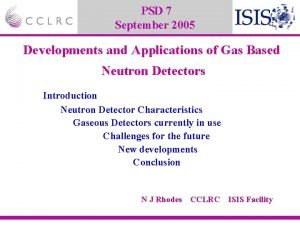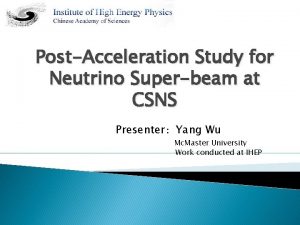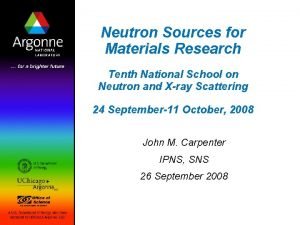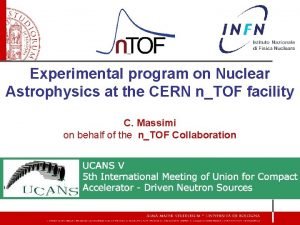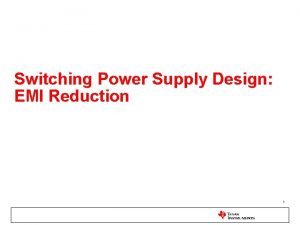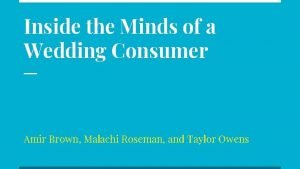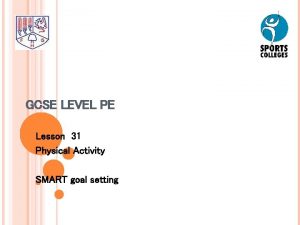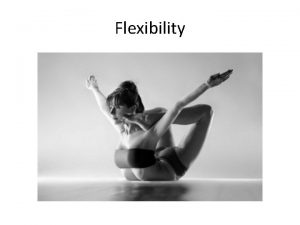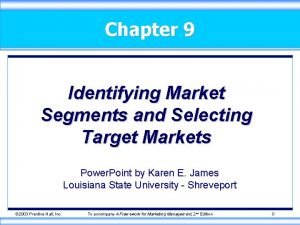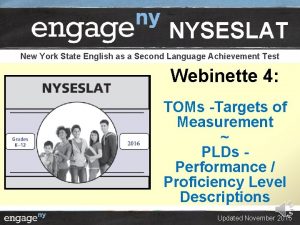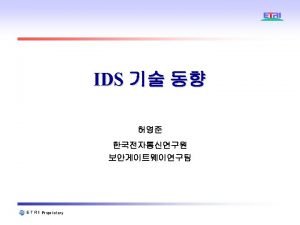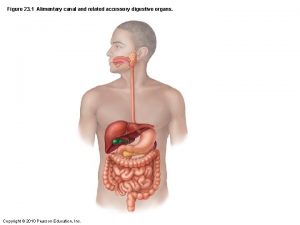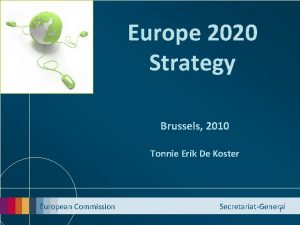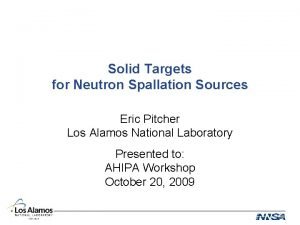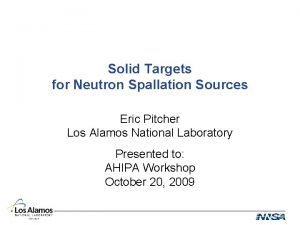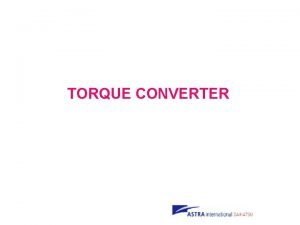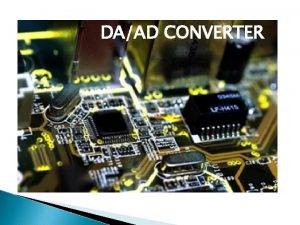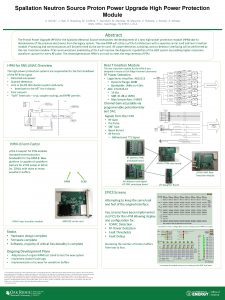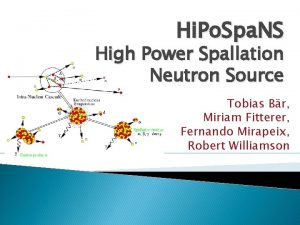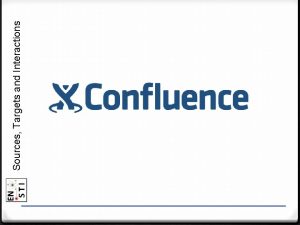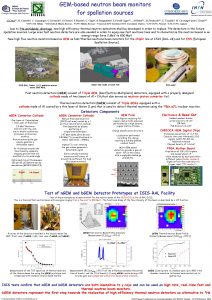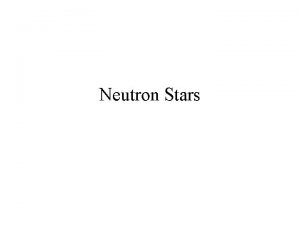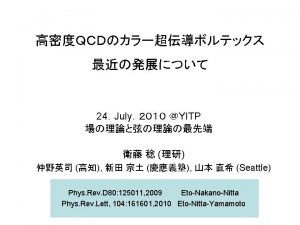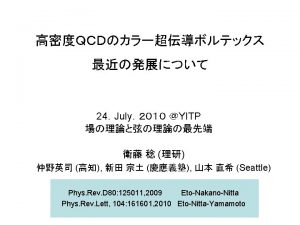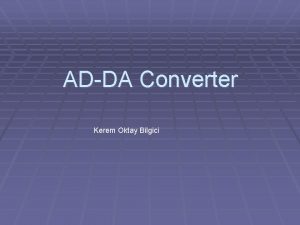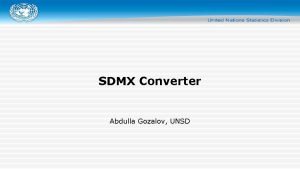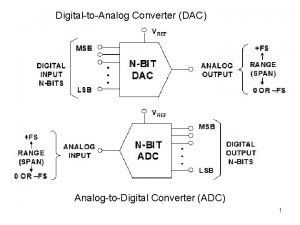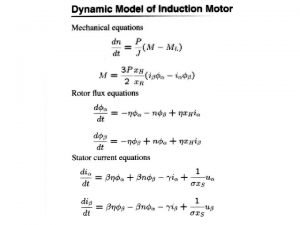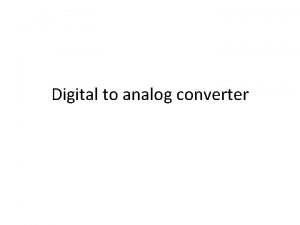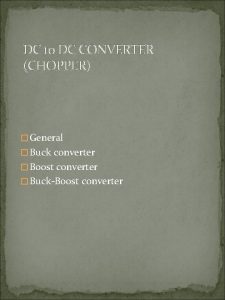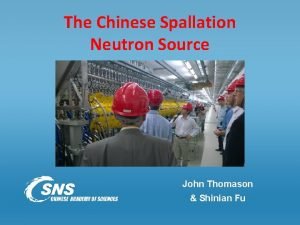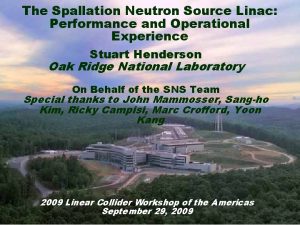Converter targets for high power spallation neutron sources































- Slides: 31

Converter targets for high power spallation neutron sources Etam Noah ESS Target division EURISOL-NET (ENSAR/NA 03) Working Group – CERN – June 27 th 2011

>Outline MW-class spallation neutron sources The ESS project ESS baseline parameters The ESS target selection process Etam Noah – EURISOL-NET (ENSAR/NA 03) Working Group – CERN – 27 th June 2011 Page 2

MW-class Spallation Neutron Sources SNS – ORNL SINQ – PSI JSNS – JAEA ESS – Lund Etam Noah – EURISOL-NET (ENSAR/NA 03) Working Group – CERN – 27 th June 2011 Page 3

Flux at Spallation Sources Etam Noah – EURISOL-NET (ENSAR/NA 03) Working Group – CERN – 27 th June 2011 Page 4

MEGAPIE @ SINQ (2006) target head lower target assembly central flow guide tube electromagnetic pumps heat exchanger safety hull Etam Noah – EURISOL-NET (ENSAR/NA 03) Working Group – CERN – 27 th June 2011 beam window Page 5

Improving Cannelloni Zr-clad Pb: predicted gain ~ 50% Scetch from Knud Thomsen Status: Operated @ 0. 9 MW April 2009 – Dec. 2010 Neutron flux gain: 54% compared to Target Mark 3 (2004 / 2005) Etam Noah – EURISOL-NET (ENSAR/NA 03) Working Group – CERN – 27 th June 2011 Ref: W. Wagner Page 6

JSNS – Hg Target • Proton Beam (design parameters): • 3 Ge. V, 25 Hz rep rate, 0. 33 m. A 1 MW • Hg Target: • Cross-flow type, with multi wall vessel • Hg leak detectors between walls • All components of circulation system on trolley • Hot cell : Hands-on maintenance • Vibration measuring system to diagnose pressure wave effects Temp. measuring point Length Height Width Weight 12 m 4 m 2. 6 m 315 ton Hg Proton beam Etam Noah – EURISOL-NET (ENSAR/NA 03) Working Group – CERN – 27 th June 2011 Page 7

JSNS – Beam History Etam Noah – EURISOL-NET (ENSAR/NA 03) Working Group – CERN – 27 th June 2011 Page 8

SNS – Hg Target > > > > Beam parameters (studied/nominal) Average power: 2 MW Energy: 1 Ge. V Pulse length: 0. 7 ms Rep. rate: 60 Hz Power absorbed in Hg 1. 2 MW Nom Op Pressure 0. 3 MPa Flow Rate 340 kg/s Vmax (In Window) 3. 5 m/s Temperature Inlet to target 60ºC Exit from target 90ºC Total Hg Inventory 1. 4 m 3 Centrifugal Pump Power 30 k. W Etam Noah – EURISOL-NET (ENSAR/NA 03) Working Group – CERN – 27 th June 2011 Page 9

SNS Beam History • Currently operating at ~ 1 MW April 3: End of life reached! Target #4 Target #3 Target #2 Target #1 Etam Noah – EURISOL-NET (ENSAR/NA 03) Working Group – CERN – 27 th June 2011 Page 10

SNS Target PIA 60 mm Inner surface of wall between bulk Hg and small channel • Target #1: • Cavitation damage phenomenon confirmed on inner wall at center of target • Outer wall fully intact; inner wall at offcenter location shows little or no damage • Damage region appears to correlate with regions of low Hg velocity, but not such a clear distinction on Target #2 Etam Noah – EURISOL-NET (ENSAR/NA 03) Working Group – CERN – 27 th June 2011 Page 11

The ESS Project Etam Noah – EURISOL-NET (ENSAR/NA 03) Working Group – CERN – 27 th June 2011 Page 12

ESS Parameters Proton beam >2. 5 Ge. V proton linac >2 m. A average beam current >1 -2 ms pulse length >16. 67 – 20 Hz rep. frequency Target options: >Molten LBE >Solid Tungsten (or W alloy) Etam Noah – EURISOL-NET (ENSAR/NA 03) Working Group – CERN – 27 th June 2011 Page 13

ESS Safety >General Safety Objectives being finalised >PSAR – work is ongoing, focusing on Target Design Concepts >EIA – work is ongoing >Safety Advisory Committee is being set up Required by authorities Foreign and domestic experts. Some cross membership with TAC. First meeting in late summer. Review GSO and PSAR work. >The required licenses are foreseen to be available by early 2013, with a slight reservation for the time needed by the Environmental Court. Risks are mitigated by Swedish government permissibility right. Etam Noah – EURISOL-NET (ENSAR/NA 03) Working Group – CERN – 27 th June 2011 Page 14

The ESS TSCS process and its outcome Rotating #Gas-cooled Granular Water-cooled Concept $Stationary Lead Bismuth Eutectic $Stationary #Helium structural containment: flowing LBE. is baseline cooling gas. Etam Noah – EURISOL-NET (ENSAR/NA 03) Working Group – CERN – 27 th June 2011 Page 15

Focused Cross Flow LBE Target FCT

Practical Motivation for LBE >History of use of Pb/LBE in previous systems: § 80 operational years of experience (ALFA class Russian submarines LBE § -cooled 155 MW fast breeder reactors) MEGAPIE at SINQ-PSI (first MW-class liquid metal (LBE) spallation target) >Pb-based target is licensable in Lund: § MEGAPIE at SINQ-PSI licensing case could benefit to ESS Lund § Hg target with its high volatility and disposal issues >Pb/LBE is planned in future projects: § reactor core coolants for fast reactors § fusion energy blanket applications (Pb. Li) § Target material for accelerator-driven systems § (ADS) (e. g. recently approved Belgian MYRRHA project) The Material Test Station under consideration at LANL also plans to use LBE to cool tungsten plates in its MW spallation target. Etam Noah – EURISOL-NET (ENSAR/NA 03) Working Group – CERN – 27 th June 2011 Page 17

Focused Cross Flow Target concept vs. ESS 2003 Ø window cooling inferior to 2003 reference design 407°C + (18°C after pulse) 325°C max. interface temperature: 351°C (+18°C) left: structural temperatures for focused cross flow target right: structural temperatures for the 2003 target design Courtesy of J. Wolters (FZJ) Etam Noah – EURISOL-NET (ENSAR/NA 03) Working Group – CERN – 27 th June 2011 Page 18

Summary: LBE >LBE targetry is proven at MW level. >With anticipated licensing and disposal difficulties for a Hg target at ESS, the LBE target option is the most viable liquid metal target alternative. >Neutronics performance studies shows about 10%difference with the best configuration with W >Focused Cross-flow is a more viable flow pattern >LBE target design can proceed by reviewing and updating existing procedures (licensing) and technologies. Etam Noah – EURISOL-NET (ENSAR/NA 03) Working Group – CERN – 27 th June 2011 Page 19

Rotating Tungsten Helium cooled Target Ro. THe. Ta ρθ

Some history >Granular Tungsten target helium cooled was first proposed by Peter Sievers for a MW neutrino factory >First we have considered spheres in a stationary target Optimum configuration for cooling, thermal shock and thermal stress Heavy cooling requirements (High Pressure!) Under the ESS condition a rotating wheel, fitted with tungsten rods and cooled with helium is a viable solution… Etam Noah – EURISOL-NET (ENSAR/NA 03) Working Group – CERN – 27 th June 2011 Page 21

Main Parameters of the Helium Cooled Rotating Granular Target >A 2. 5 Ge. V elliptic Gaussian beam with an RMS of x= 5 cm and y= 1. 5 cm (beam footprint at 4 of 20 cm x 6 cm), an average power of 5 MW, pulsed at 20 Hz >The wheel is rotating at 30 RPM (0. 5 Hz) >The energy deposition calculated with FLUKA gave a maximum Power density (time average for 1/40 of the wheel) of 75 W/cm 3 (40 times less than in the static target case). >External wheel diameter is 150 cm and internal diameter of 50 cm. The helium is blown over the total surface continuously. >Initially rods of 2 cm diameter, now 1 cm diameter (90% packing) Etam Noah – EURISOL-NET (ENSAR/NA 03) Working Group – CERN – 27 th June 2011 Page 22

Practical Motivation for Helium Cooling >Objectives: Avoid Liquid metal technology Avoid Water cooling / corrosion issue related to tungsten target and therefore avoid cladding >Advantages: Known technology Low activity in the cooling fluid Leak tightness >Drawbacks: Pressurized gas equipment (3 -10 bar) Leak tightness Etam Noah – EURISOL-NET (ENSAR/NA 03) Working Group – CERN – 27 th June 2011 Page 23

Practical Motivation for a Rotating Target >Objectives: Increase lifetime (window, tungsten…) Alleviate the heat removal >Advantages: Dilution of specific activity and after heat Less frequent maintenance and handling of radioactive material Solid waste Upgradeable for higher beam power >Drawbacks: Not yet proven concept (but we do not need to re-invent the wheel!) Rotating seals to be adapted from existing solutions Heavy assembly Etam Noah – EURISOL-NET (ENSAR/NA 03) Working Group – CERN – 27 th June 2011 Page 24

Neutronic performance Brightness at 5 Me. V (left) and at 10 Me. V (right) on the moderator surface for a 1 ms pulse length. The rotating target made of rod cooled by helium will allow a density of 90% of the raw material, which shall give a performance close to the pure tungsten configuration. courtesy F. Sordo et al. Etam Noah – EURISOL-NET (ENSAR/NA 03) Working Group – CERN – 27 th June 2011 Page 25

Neutronic performance >Franz Gallmeier investigation (previous TSCS meeting) extended Rotating target configuration (run though optimization loop) Extrapolation with density (not so accurate) Element W W sphere W Rods density Density fraction (g/cm 3) relative to raw material 100. 0% 19. 4 72. 2% 14 90. 7% 17. 6 Φcold@10 m (n/cm 2/pr Perf in % ot. ) vs. Best Loss in % vs. Best 6. 59 E-08 100. 00% 5. 66 E-08 85. 89% 6. 28 E-08 95. 28% 0. 00% Calculated 14. 11% Calculated 4. 72% Extrapolated Comment Tungsten is the most favourable target material, and its dilution is not affecting significantly the neutron production *DENSIMET is a tungsten alloy with appropriate properties courtesy F. Gallmeier Etam Noah – EURISOL-NET (ENSAR/NA 03) Working Group – CERN – 27 th June 2011 Page 26

Thermo-mechanical study 1 cm Rods With a more moderate He-cooling circuit (Po = 3 Bar, inlet v(He) of 4 m. s-1, mass flow of 3 kg/s) • The peak temperature in the hottest rods is about 485°C • Helium ∆Tbulk= 200 K • Stress in the rods is very low even in a fatigue regime (endurance), about 10 to 20 Mpa Temperature [°C] Maximum temperature vs. Time 500 480 460 440 420 400 380 0 2 4 Time [s] Etam Noah – EURISOL-NET (ENSAR/NA 03) Working Group – CERN – 27 th June 2011 6 8 10 Page 27

Thermo-mechanical study 1 cm Rods For 3 kg/s mass flow rate for 3 bar He Here the pressure drop is 0. 1 bar equivalent to 62 k. W of pumping power. Etam Noah – EURISOL-NET (ENSAR/NA 03) Working Group – CERN – 27 th June 2011 Page 28

Helium Loop and ancillaries loop / Enclosure Etam Noah – EURISOL-NET (ENSAR/NA 03) Working Group – CERN – 27 th June 2011 Page 29

Summary: Ro. THe. Ta >3 bar of pressure seems a viable option with 1 cm rods, but further study shall be carried on to confirm and determine the minimum pressure acceptable >Neutron yield is optimum >Some of the main challenges lie in the replacement of the target and its associated downtime >Attention has to be paid to local leak and radioactive release >Special attention has to be paid to the rotating seal Etam Noah – EURISOL-NET (ENSAR/NA 03) Working Group – CERN – 27 th June 2011 Page 30

Summary >Main factors driving target choice/design: • • • Safety Cost Neutronics (minimal) • • When possible, move away from short beam pulse lengths. Cavitation lifetime limiting for liquid metal targets > 1 MW. • • Several ongoing: ESS, MYRRHA, SNS-STS, CSNS, MTS. Solid and liquid targets considered. >CW vs pulsed beams: >Outlook for future projects: Etam Noah – EURISOL-NET (ENSAR/NA 03) Working Group – CERN – 27 th June 2011 Page 31
 Spallation neutron source
Spallation neutron source Spallation neutron source
Spallation neutron source Spallation neutron source
Spallation neutron source Spallation neutron source
Spallation neutron source Buck converter and boost converter
Buck converter and boost converter Print and web sources
Print and web sources Explain important of watershed management
Explain important of watershed management Active power reactive power apparent power
Active power reactive power apparent power Warehouse goals
Warehouse goals Writing learning targets
Writing learning targets Racial etiquette targets
Racial etiquette targets Brides magazine targets consumers who are in
Brides magazine targets consumers who are in Targets of change
Targets of change Smart targets pe
Smart targets pe Agonist antagonist muscles
Agonist antagonist muscles Identifying market segments and targets chapter 9
Identifying market segments and targets chapter 9 Identifying market segments and targets chapter 9
Identifying market segments and targets chapter 9 Forensic science learning targets
Forensic science learning targets Product learning target example
Product learning target example Learning targets knowledge, reasoning, skill product
Learning targets knowledge, reasoning, skill product Identifying market segments and targets chapter 9
Identifying market segments and targets chapter 9 Nyseslat levels
Nyseslat levels Learning target
Learning target The nfl targets several different market segments
The nfl targets several different market segments Early childhood education barbados
Early childhood education barbados Identifying market segments and targets
Identifying market segments and targets Physical targets
Physical targets Multiattack multiple targets
Multiattack multiple targets Identifying market segments and targets
Identifying market segments and targets Surfaces of thyroid gland
Surfaces of thyroid gland Alimentary canal figure
Alimentary canal figure Tonnie de koster
Tonnie de koster
